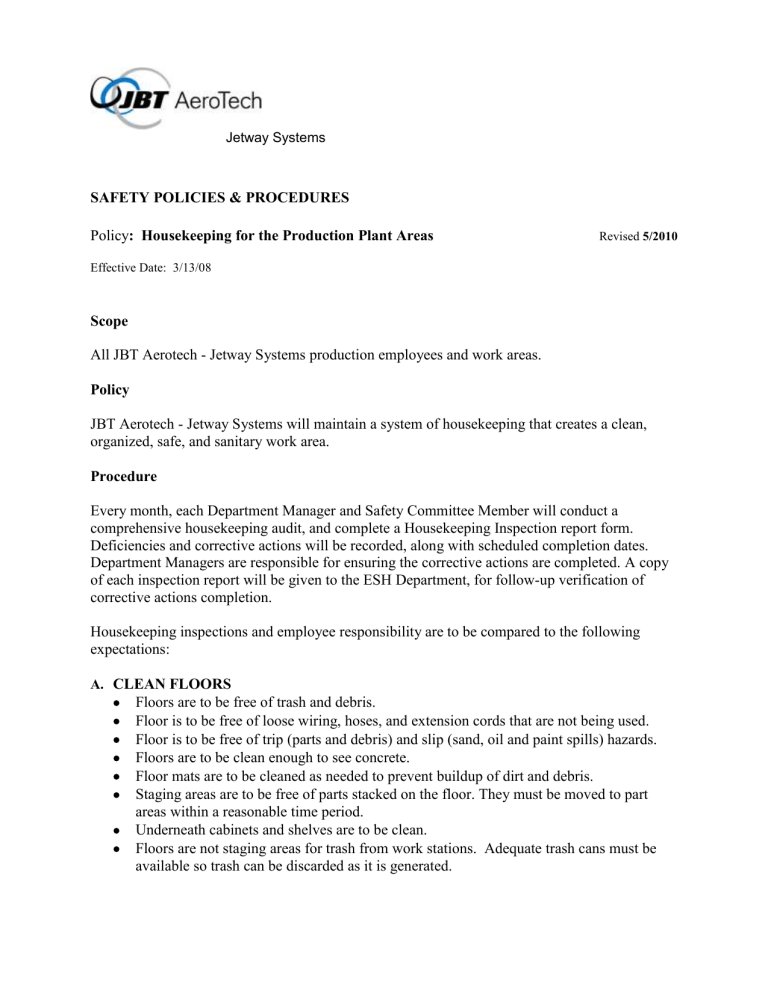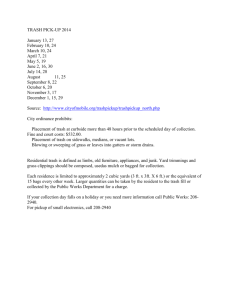
Jetway Systems SAFETY POLICIES & PROCEDURES Policy: Housekeeping for the Production Plant Areas Revised 5/2010 Effective Date: 3/13/08 Scope All JBT Aerotech - Jetway Systems production employees and work areas. Policy JBT Aerotech - Jetway Systems will maintain a system of housekeeping that creates a clean, organized, safe, and sanitary work area. Procedure Every month, each Department Manager and Safety Committee Member will conduct a comprehensive housekeeping audit, and complete a Housekeeping Inspection report form. Deficiencies and corrective actions will be recorded, along with scheduled completion dates. Department Managers are responsible for ensuring the corrective actions are completed. A copy of each inspection report will be given to the ESH Department, for follow-up verification of corrective actions completion. Housekeeping inspections and employee responsibility are to be compared to the following expectations: A. CLEAN FLOORS Floors are to be free of trash and debris. Floor is to be free of loose wiring, hoses, and extension cords that are not being used. Floor is to be free of trip (parts and debris) and slip (sand, oil and paint spills) hazards. Floors are to be clean enough to see concrete. Floor mats are to be cleaned as needed to prevent buildup of dirt and debris. Staging areas are to be free of parts stacked on the floor. They must be moved to part areas within a reasonable time period. Underneath cabinets and shelves are to be clean. Floors are not staging areas for trash from work stations. Adequate trash cans must be available so trash can be discarded as it is generated. B. MATERIAL/PARTS, ECT. PROPERLY STORED Materials and parts are to be stored in a neat and orderly fashion and their place of storage is to be identified with the material or part numbers. All floor inventory and staging areas are to be marked so that materials and parts can be arranged and stored in a neat manner. Pallets, racks and roll-arounds are to be stacked or lined-up neatly. Parts are not to be stored on cabinets, tool boxes, etc. C. MACHINES, EQUIPMENT, ECT. CLEAN Machines and equipment (cabinets, furniture, computers, etc.) are to be kept clean. Machines and equipment are not to have coolant, oil, grease or dirt build-up on them. Machines are not to be used as storage areas for parts. Machines and equipment are not to be used as trash containers. Access to electrical panels, exits, and fire extinguishers will be kept free of obstructions. Oil, paint, air and coolant leaks are not permitted. Die racks must be stored in a neat and orderly fashion and kept clean. Paint booths should be free of overspray, and filters must be changed on a regular basis. Sand blaster area should not have build-up of dust around area. D. CLEAN/ORDERLY WORK STATIONS Workstations are to be clean and orderly. Brooms and dust pans are to be stored properly. Fixtures, hand tools, vises, gauges, etc., must be kept orderly when at work stations. Hoses, and electrical cords should be rolled up when not in immediate use. Tables should be cleared when not in use. Cabinets, lockers and tool boxes are to be kept clean and orderly, and should be closed when not in use. Debris, dirt and other foreign matter is not to be excessive at the work station. Spitting (including tobacco, gum, sunflower seeds, etc.) onto the floor or into parts bins, toilets, etc. is forbidden. Trash cans are to be emptied daily. Trash cans are to be kept clean and dent free. Work stations are to be cleaned before going to another job and at the end of the shift. E. YARD All trash is to be disposed of properly. Materials and parts are to be stored in a neat and orderly fashion. Their place of storage is to be identified with the material or part numbers. Floors are to be marked so that materials and parts can be arranged and stored neatly. Pallets, racks and roll-a rounds are to be stacked or lined up neatly. F. WALKWAYS Walkways are to be kept clean and free of debris. Striping guidelines: -Stripes will be a minimum of 4” wide. -When striping, lines should be chalked, then taped on both sides of the line before painting. -Yellow traffic Paint (water reducible) should be used. -Lines should be kept in good condition and repainted as needed. G. OFFICE AREAS Desks, bookcases and cabinets are to be clean and orderly. Parts, tooling, etc., (general clutter) are not allowed. Paperwork (computer print-outs, kit sheets, work orders etc.,) should be stored properly. Computer terminals are to be kept clean and dust free. Floors are to be kept clean. H. WALLS Walls should be maintained clean and free of dust and dirt. All Insulation should be maintained and securely fastened. All support columns need to be cleaned-out and not used as storage bins. All siding should be securely attached.

